 |
 |
|
|
|
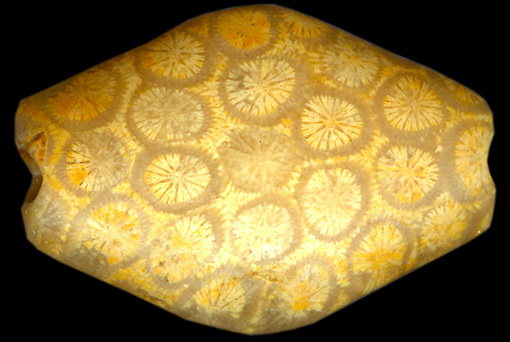
|
ANCIENT FOSSIL BEADS
Beads made out of fossil material
This extraordinary assemblage of beads, painstakingly
crafted from an assortment of fossil stone materials, holds a
cherished place in my collection. The majority of these
captivating relics trace their origin back to the nascent phases
of the Indus Valley civilization, and even earlier, thereby
shedding light on a distinctive attribute of this ancient
society - their profound admiration for the uncommon and the
rare in their bead-making materials. Their fondness for such
materials is apparent in the wealth of antiquities recovered
from their early settlements, where a profusion of beads made
from fossil materials have been unearthed.
Intriguingly, it's plausible to suggest that the people from
6,000 years ago were engaging in a form of 'hunt' for bead
materials. Despite having settled into agrarian lifestyles,
their mental framework was still largely shaped by their
hunter-gatherer past. This mindset might have been what spurred
them to seek out the unique and the unusual in their
surroundings, and bring their findings to life in their
exquisite beadwork.
|
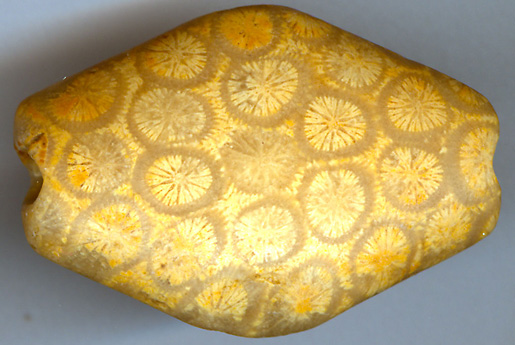 |
 |
A remarkable instance of
synchronicity,
as defined by
C.G. Jung,
occurred a fortnight after I acquired these magnificent Indus
beads in Thailand. As I strolled along a beach in Sri Lanka,
bathed in the glow of the setting sun, my eye was drawn to a
certain coral among the multitude scattered across the sand. It
was as if my gaze was conditioned to seek out synchronicities:
the fossil patterns in the large yellow Indus bead above bore an
uncanny resemblance to those in the coral I chanced upon.
Below, another enormous soft stone bead from the pre Indus
period showcases similar fossilized patterns. It is not as
outstanding as the bead above but it is still a testament to the
ancient people's skill in capturing the intricate beauty of
nature in their beadwork, and their keen eye for unique and rare
materials. Due to impressions of fossil
prints – this in itself simple stone has got its own “wow factor”.

38,5 * 30.5 * 11 mm
|
Click on the
pictures for
larger images
|
|
|
 * *
The Sandstoned |
|
AFB 1
- 30 *11 mm -
Aprox. age: 5.500+ years |
Hard versus
soft stone beads
The ancient fossilized bead displayed above, is composed of sandstone. It offers a fascinating
glimpse into the past, reaching back to even pre-Indus times.
The transition from a relatively egalitarian hunter-gatherer society to
a more hierarchically structured agricultural society is subtly mirrored
in the evolution of bead-making and the choice of materials employed.
Early beads, like the fossilized sandstone example presented here, were
predominantly made from softer stones, reflecting the simpler tools and
techniques of the time.
However, as societies became more complex and status-oriented, the
choice of bead-making materials also evolved. Materials such as jasper
and agate, significantly harder and thus more challenging and
time-consuming to work with, started to dominate the bead-making scene.
The painstaking process of crafting these hard stone beads could be seen
as a metaphor for the societal shift towards hierarchy, with these
intricate beads becoming symbols of prestige and status.
Yet, softer stones didn't entirely vanish from the bead-making
landscape. They managed to retain their relevance, as long as they
exhibited rare aesthetic qualities. In essence, to stay competitive in
the face of the naturally complex patterns and vibrant colors found in
agate and jasper, softer stones needed to offer something unique. This
niche was filled by attractive fossilized sandstone, which could still
hold its own against the much more labor-intensive cryptocrystalline
agate or jasper beads. Unfortunately most of the sandstone beads have
not survived the grinding tooth of time. So displayed below you will
find mostly fossilized agate and jasper beads.
|
|
|
|
 * *
The Sandman |
|
AFB 2 -
62 - 36,5 * 11 mm
-
Aprox. age: 5.500+ years |
In an intriguing continuation of this trend, it seems that the tradition
of valuing fossilized materials highest persevered into the hard stone
bead-making period. If this hypothesis holds true, then one could
conjecture that beads made from fossilized agate and jasper would have
been considered the apex of prestige, occupying the pinnacle of the
societal hierarchy mirrored in the world of ancient bead-making. We find
a lot of marvelous beads made of fossilized material especially
in the early Indus period.
Such a bead is the one you can observe below!
|
|
|
|
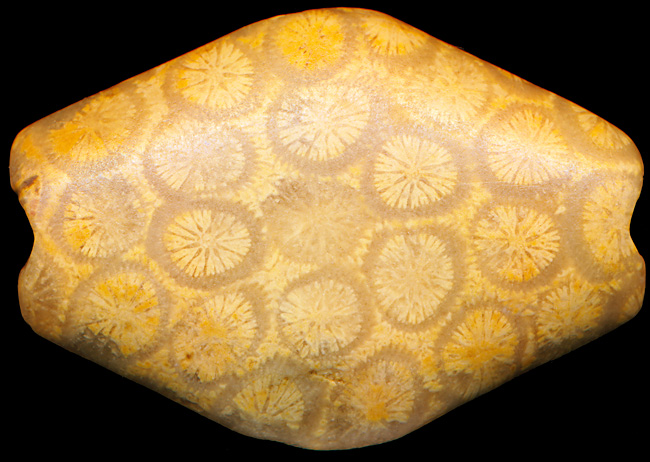
Petrified Coral Canvas
What strikes the observer is not merely the presence of these
agathized corals, but their near-symmetrical arrangement on the bead's
surface, a testament to the ancient artisan's keen eye for balance and
aesthetics. Each coral, with its unique structure and pattern,
contributes to an overall harmonious design, creating an intricate
mosaic of natural artistry.
Their placement appears deliberate, suggesting that the bead's creator
had a deep appreciation for the inherent beauty of these fossils. The
symmetrical layout enhances the visual appeal of the bead, transforming
it into a miniature canvas showcasing the elegance of the natural world.
The existence of such a bead is an eloquent reminder of the deep
connections between human culture and nature. It underscores our
enduring fascination with the organic world and our desire to capture
and carry its beauty with us, no matter how much time passes.
Not for sale
|
|
AFB 3 - 41 * 28 * 11 mm
- Aproximate age:
5.500 years |
|
Interestingly, the magnificent
yellow sandstone bead showcased above inspired me to
formulate a unique, yet intuitive, definition of a pre Indus
bead. The defining feature lies within its hole:

If you can draw a comfortable
breath through the hole, it's likely a pre-Indus or an Indus
Valley bead. A Mauryan bead, however, would make the process
slightly challenging, leaving you feeling slightly breathless.
As for a Gupta bead, its diminutive hole would render the task
nearly impossible. This metaphor perhaps serves as a commentary
on the trajectory of Indian bead-making. Starting from the Gupta
period and onwards, it seems to me that the craftsmanship and
artistry that once defined Indian bead-making began to lose its
breath. But, of course, this is a personal perspective.
'SILLIFIED' FOSSILS
The fascinating fossil beads showcased below fall under a
specialized category known as "silicified" fossils. This term is
derived from the intricate process that these fossils undergo,
where their original forms, and occasionally even their
intricate internal structures, are gradually replaced by
"silica" (SiO2), transmuting the organic into the inorganic. The
transformative process results in the creation of a fossil
that's essentially an exact silica replica of the original
organic material, immortalizing it in stone.
This transformation occurs in one of two possible forms. In some
instances, the silica takes on the form of granular quartz,
which is coarsely crystalline and offers an interesting texture.
In other cases, it manifests as a variety of cryptocrystalline
quartz and moganite known as chalcedony, which is translucent
and imparts a captivating charm to the fossil.
|
|
|
|
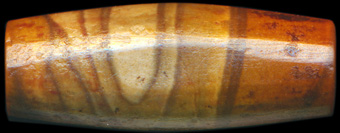

|
|


Petrified Poetry
The photographic scan
above unveils the unique texture and irregular surface characteristics
of these beads made out of jasperized wood. It's an intriguing artifact
of the more 'primitive' polishing technique employed by their ancient
creators, clearly diverging from later standard practices in the Indus
Period.
In this process, rather than opting for finer
abrasives
that would have yielded a smoother, more uniform finish, the artisans
used coarser materials. This choice has imparted a distinctive,
roughened texture onto the beads, where the lines in the original wood
become more visible.
Not for sale
|
|
AFB 2 - 22 * 8 mm
-
Aprox. age:
4.500+ years |
|
|
|

Rustic
Resonance
Not for sale
|
|
AFB
3
- 30 * 7 mm
-
Aprox. age:
4.500+ years |
|
|
|
*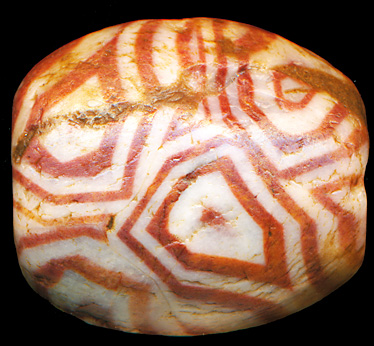
Fossilized
Fantasia
The repetetive geometric patterns on this variegated jasper
Indus-bead speaks for itself. The bead is scarred, but it still
manages to pass on the ancient message of beauty understood as
order in chaos.
Not for sale
|
|
AFB 4
- 23 * 20 * 9 mm -
-
Aprox. age: 5.000+ years |
|
|
|
*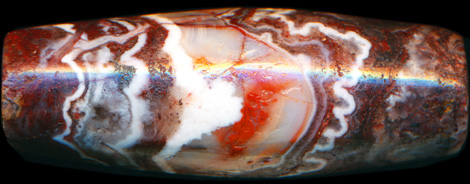
Jasper's Time
Capsule
Not for sale
|
|
FB5 - 30,5 * 11 mm
-
Aprox. age:
4.500+ years |
|
|
|
*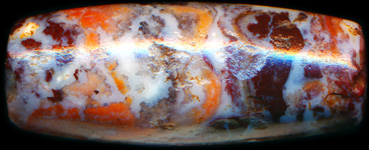
Ripples of the
Past
Not for sale
|
|
AFB 6 - 24 * 9 mm
-
Aprox. age: 4.500+ years |
|
|
|
 * *
Jasper's
Journey
Not for sale
|
|
AFB 7
- 28,5, 8 mm
Aprox. age: 4.500+ years |
|
|
|
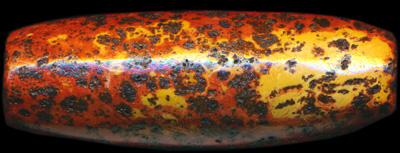 * *
Autum Leaves
|
|
AFB 8
- 25,5 * 8,5 mm
Aprox. age: 4.500+ years |
|
|
|
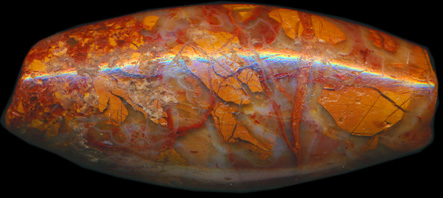 * *
Agate Lake
|
|
AFB 9
- 28 * 12 * 11 mm -Aprox. age:
4.000+ years |
|
|
|
*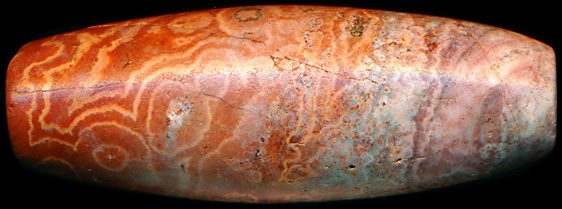
Petrified
Poetry
|
|
AFB 10
- 36 *12 mm
- Aprox. age: 4.500+ years |
|
|
|
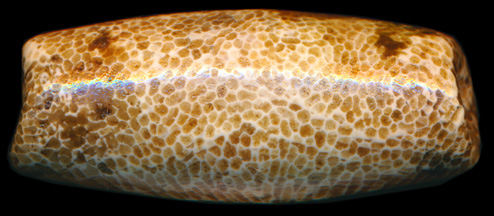
Fossilized
Fragments
|
|
AFB 11 - (EIV 7)
- 30,5 * 12 mm -
Aprox. age: 4.500+ years |
|
|
|
*
Agate Ancestry
|
|
AFB
12 - 18 * 11 * 9,5 mm -
Aprox. age: 4.000+ years |
|
|
|
*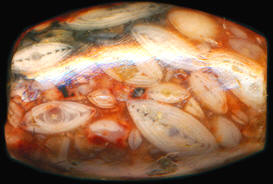
Petrified Ufos
1
Not for sale
|
|
AFB 13 - 17 * 11,5 mm - SOLD |
|
|
|
*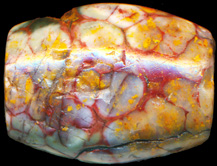
Petrified Ufos
2
Not for sale
|
|
AFB 14
-
14 * 10 * 7,5 mm
- Aprox. age:
4.500+ years |
|
|
|
*
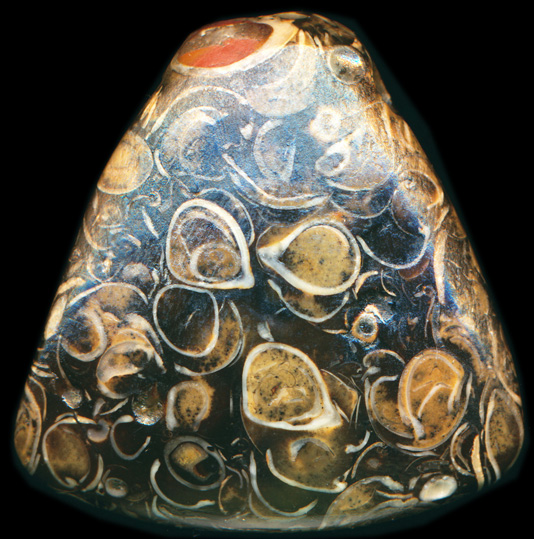
Neolithic
Sentinels 1
Not for sale
|
|
AFB 15 -
33 * 33 * 11
mm -
Aprox. age: 6.000+ years |
|
|
|
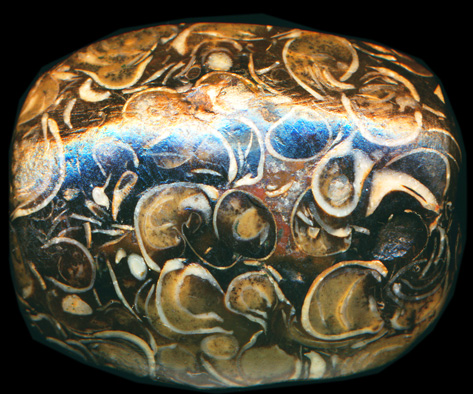
*Neolithic
Sentinels 2
Not for sale
|
|
AFB 16 -
29 * 28 *
12,5 mm
- Aprox. age:
6.000+ years |
|
|
|
*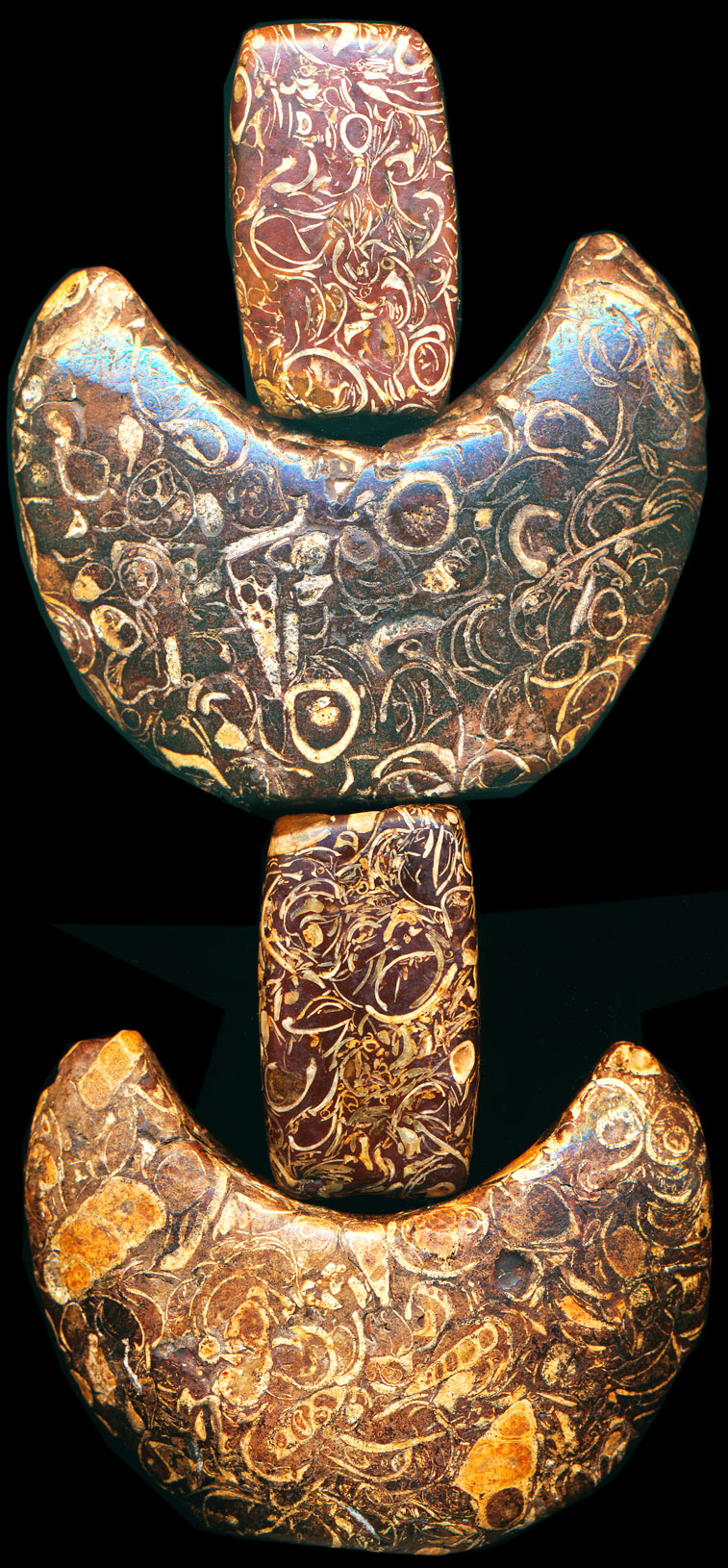
Stone Henge
Not for sale
|
|
AFB 17 -
100 * 48 *
14 mm -
Aprox. age: 6.000+ years |
|
|
|
*
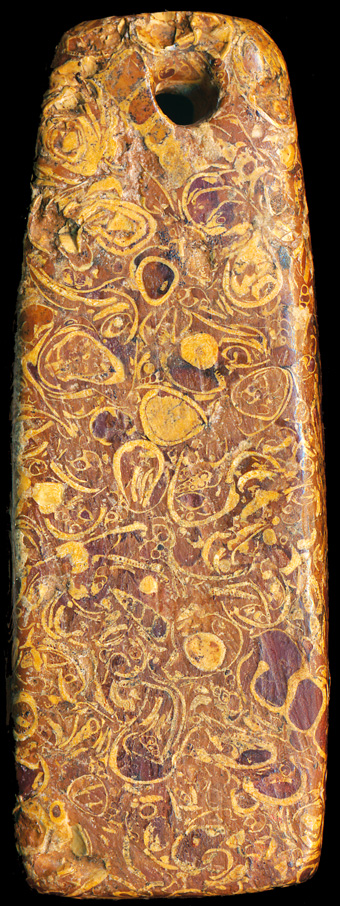
Fossilized
Coral Tapestry
|
|
AFB 18 -
58 * 21 *
9,5 mm -
Aprox. age: 6.000+ years |
|
|
|
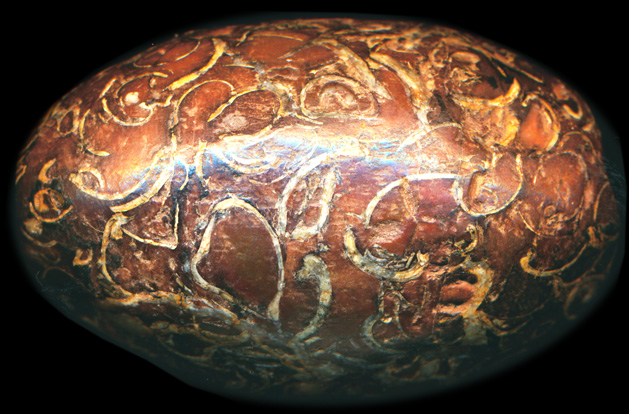 * *
Seabed Symphony
|
|
AFB 19 -
40 * 24 mm -
Aprox. age: 6.000+ years |
|
|
|
*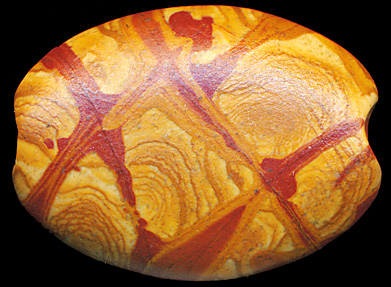
|
|
AFB 20
- 24 * 18 * 7,5 mm - SOLD |
|
|
|
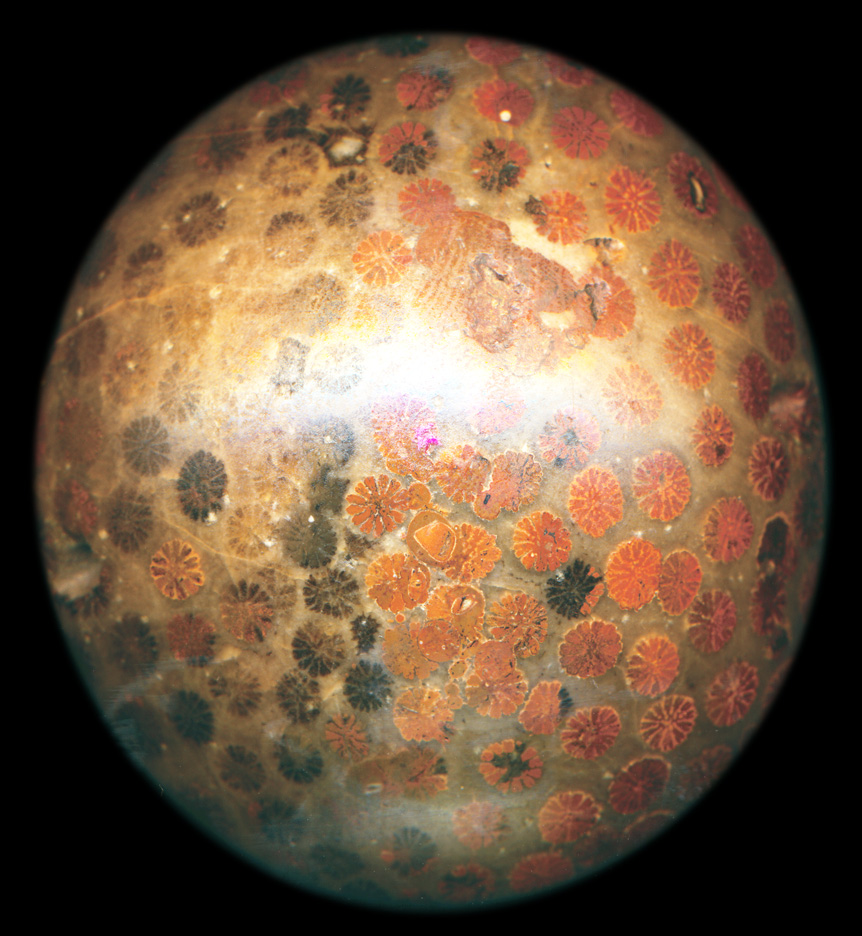
Maritime
Pre-Cambric Memory
Not for sale
|
|
AFB 21 -
(EIV 1) - 56
* 20 mm -
Aprox. age: 5.000+ years |
|
|
|
*
The
Tiger
Not for sale
|
|
AFB 22 -
(EIV 3) -
66,5 * 19,5 mm -
Aprox. age: 5.000+ years |
|
|
|
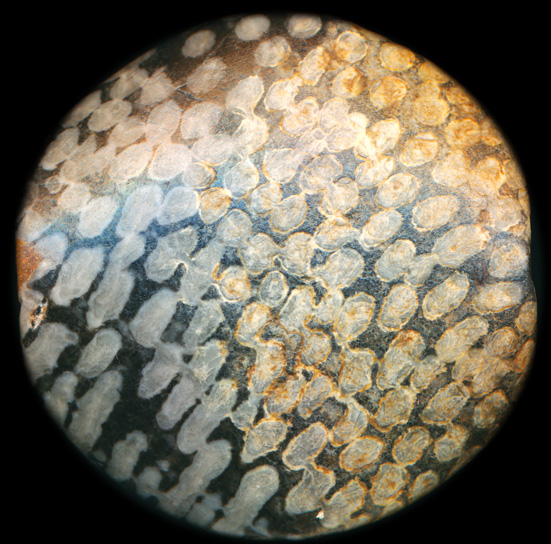 * *
Oceanic Opus
|
|
AFB 23 -
33,5 * 11 mm -
Aprox. age: 5.000+ years |
|
|
|
*
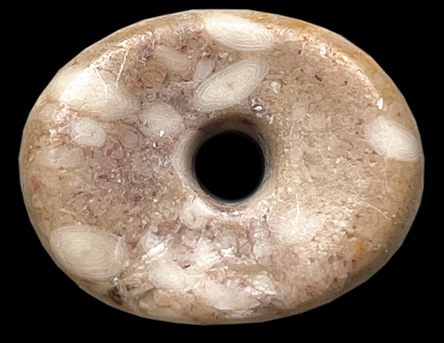
Tide's
Testament
|
|
AFB 23 -
17,5
* 14 * 6 mm -
Aprox. age: 5.000+ years |
|
|